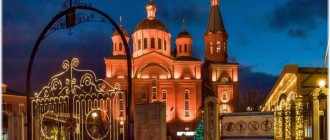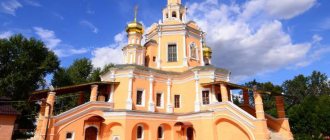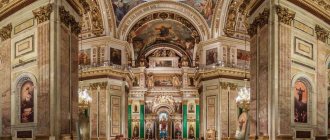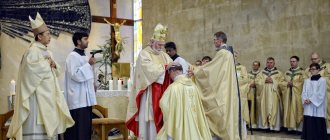PRESBYTERIANS, a Protestant denomination in which church authority is vested in elected representatives of local communities (congregations) or larger associations - presbyteries. The name of the denomination goes back to the Greek. presbyteros (“senior”, “elder”), it refers to a special system of church government carried out by presbyters, or elders. In Europe, churches of this type are called Reformed. The Presbyterian and Reformed churches together constitute the largest branch of Protestantism, numbering approx. 46 million people.
Creed.
Also on topic:
REFORMATION
According to Presbyterian theology, God revealed himself in nature, but since man is blinded by sin, God further provides him with a separate revelation recorded in the Bible. God the Holy Spirit enables the believer to recognize and understand the word of God in the Bible. The Word of God, contained in the Old and New Testaments and made clear by the Holy Spirit, is to guide all the affairs of both the individual Christian and the corporate Christian church.
Presbyterians believe in the existence of a Triune God and recognize both the divine and human nature of Jesus Christ. They accepted the common doctrines of original sin and eternal life for all Christians, and many believed in the reality of the virgin birth. Considering themselves the spiritual heirs of the French theologian John Calvin (1509–1564), modern Presbyterians continue to believe in God Almighty, but do not share Calvin's views on election and predestination (to salvation or destruction).
Also on topic:
PROTESTANTISM
Presbyterians recognize the sacraments of baptism and the Eucharist, or communion, viewing each as a means of achieving the grace of God. Baptism is a sign that a Christian has died to sin and has been raised to new life in Christ through the direct work of the Spirit of God. Infants are baptized to fulfill God's promise to the children of believers. Different types of baptism are practiced - sprinkling, pouring and immersion, but in any case, the rite of baptism can only be performed by a pastor. Baptism is performed in the name of the Triune God. Godparents are not required and are present only in rare cases. The Eucharist is the remembrance of Christ's death on the cross. Believers are convinced that Christ is spiritually present in the sacrament, and his presence is assumed in all services; but it is not considered that it is actually present in bread and wine, at least for some time. The frequency of celebrating the Eucharist is not regulated; In the past, many churches celebrated communion once every three months, but in recent decades, some communities have begun to take communion more frequently. The minister repeats the words of Christ by which the Eucharist was instituted (according to the Apostle Paul's account of the Last Supper, 1 Cor 11: 23-26), then passes the bread on a platter to the leading elders, who distribute it to the participants in the service, who remain seated in the pews. Following this, wine is distributed.
Social ministry of churches
Separately, we should talk about the social ministry of the Presbyterian and Protestant churches in general.
“Let us not become weary in doing good, knowing that in due season we will reap” (Gal. 6:9).
A Christian cannot only care about his own well-being, but also about improving the quality of life of other people according to the principle: “Love your neighbor as yourself” (Mark 12:31). Conscious of the value of every human person created by the Creator in His own image and likeness, we define our “neighbor” not by religious, national or family affiliation. For us, a neighbor is someone who, living next to us, needs the help that we are able to provide.
The motive for the charity of the Presbyterian Churches is not the advertising of denominational virtues or the desire for self-affirmation, but the gospel principle: “And whatever you do, do it heartily, as for God, and not for men” (Col. 3:23). Callousness, indifference and indifference are alien to the gospel spirit. Next to every suffering person, no matter what caused his suffering, we see the compassionate Christ. The example of Christ and His love, which conquers our hearts, determine the participation of the Churches in the needs of people.
Most often, social problems and physical suffering of people originate in problems of a spiritual nature. In their social service, the Church helps to overcome not only the consequences of sin, such as an increase in the number of divorces, child crime, the demographic crisis, and all kinds of addictions, but also works to eliminate their causes, offering society programs of spiritual and moral recovery. For example, participation in raising children in orphanages, boarding schools, street children, guardianship of infirm people, providing assistance to people at risk.
Organization.
Presbyterian churches are governed by a body of ministers that includes deacons, governing elders, and preachers; the latter are also called instructing elders. The community elects elders and deacons from among its members by secret ballot. The governing elders, along with the preachers, are responsible both for the government of the local congregation and for the state of affairs throughout the Presbyterian community. Deacons care for needy and sick parishioners. Presbyterians emphasize the equality of all believers and share the doctrine of a universal priesthood of believers. Ordination is not accepted to achieve another spiritual status, but simply as a sign of the fulfillment of a certain function. If a preacher is assigned to work in a local congregation, he is called a pastor. Preachers administer the sacraments and the rite of ordination (initiation). Clergymen have equal status; there is no rank of bishop. The priesthood is lost only through death, through defrocking or voluntary renunciation. In some Presbyterian congregations, a woman may become a preacher. Presbyterians view ordination as a ministry within not only the denomination, but also the universal church.
Also on topic:
HUGENOTS
Presbyterian and Reformed churches are governed by tribunals, or courts, which have four levels, consisting of preachers and governing elders, and in some Reformed churches, deacons. Local congregations are governed by sessions, and in Reformed churches by consistories. The sessions determine the order of all spiritual affairs, such as, for example, the program of worship in the community: they have the power to accept, excommunicate and punish the faithful. The sessions of a particular district form presbyteries, or ranks (among the Reformed). Although only the local congregation has the authority to choose preachers, its choice must be approved by the presbytery, which has the power to move ministers, remove them from service, organize new churches, and control church mergers. Presbyteries are grouped around synods, which meet annually and have little real power. The highest body in Presbyterianism is the general (for the Reformed - national) synod, which meets annually. It consists of members elected by presbyteries and vested with legislative, executive and judicial powers.
The germ of the Presbyterian church structure can be found in the New Testament, where it is said that an ordinary congregation has one leader and several assistants. The modern Presbyterian system of government, which emerged during the Reformation, differs from the methods of government in other denominations. Congregational organization provides greater independence for local communities. Thus, under the episcopal system, the control of individual churches and priests is vested in the bishop rather than in the presbytery; and the organizational structure of the Roman Catholic Church provides for the supreme earthly ruler of the universal church - the pope.
Structure of Presbyterian churches
Presbyterian Churches also have their own hierarchical ladder. The grassroots structure is the communities. The ministers are the pastor (who has theological training) appointed by the elders, the elders (responsible for financial and administrative matters) and the deacons (a technical position). And also missionaries. Elders (presbyters) are appointed by God to provide spiritual care for the community of God. The elders were to be elected by the community. Deacons were intended primarily to serve others (Acts 6:1-6); they were to have the same high spiritual qualities as the elders (1 Tim. 3:8-10). Deacons help the needy, the sick, the lonely and all those who suffer. They collect donations and donations and distribute them. They take care of the community's property. The Assembly of Elders monitors how deacons perform their duties.
Worship.
At the initial stage of their history, churches of the Reformed confession on the European continent adhered to a clearly regulated ritual in their services. However, British and American Presbyterians, influenced by Puritanism, sought to simplify the service. They abandoned liturgical prayers and pompous priestly vestments and preferred singing as a whole community. Later, American Presbyterians, influenced by living conditions on the frontier and the growth of revivalism (spiritual revivalism), further simplified the forms of their worship. During the last part of the 19th century. these forms were reviewed throughout the denomination, after which their gradual reform began. In 1906, the Presbyterian Church in the United States adopted the Book of Common Worship; by 1970 this manual was replaced by The Worshipbook (the use of these books is not strictly required).
The sessions of individual churches have the right to determine their own liturgical forms. The main service takes place on Sunday morning. It involves prayer and the singing of hymns by some of the congregation, readings from the Bible by the preacher or his assistant, and is usually accompanied by one or more church hymns. The preacher preaches a sermon on a topic of his choice. The service usually lasts about an hour; Often, for the convenience of believers, two identical services are held in a row. The preachers are dressed in clothes that look like academic robes. The throne on which the sacrament of the Eucharist is celebrated is located in a prominent place in front of the preaching pulpit or at the rear of the church altar.
Social justice
Social justice requires that all people, regardless of gender, race or social background, have the same opportunities and that everyone is equal before the law. But this does not imply the same level of material well-being. Quite the contrary: hard work, diligence, enterprise and creativity deserve to be rewarded in the form of higher income.
Today, economic theories are widespread, according to which the main source of wealth is the exploitation of man by man. In our opinion, this is not always the case, despite a sufficient number of examples of inhumane attitudes of people towards each other. Free enterprise and private property and free enterprise do not always breed exploitation. Wealth is much more the result of people's creativity and initiative, the fruit of their hard work, than the result of the simple possession of natural resources or the unfair use of other people.
The social ministry of the Churches is built on the principle of social justice. Justice provides for (providing to everyone) the inalienability of rights belonging to a person (belonging to him). They are given to him by God and determine his dignity (personality). The basis of social justice is the universal purpose of earthly goods. Churches in their social service consistently defend all kinds of justice, especially social justice. However, the social ministry of the Churches is not limited only to the restoration of justice where it has been violated, but also includes the struggle for the dignity of the human person. The means of this struggle are mercy and love (Mic. 6:8). Christian mercy and love extend beyond the boundaries of human justice - they do not contradict it, but come into force where justice is powerless. Justice may demand punishment for the guilty, but it is not able to correct him, but love and mercy do not cease to fight for a sinner and stumbled person, trying to restore his self-desecrated dignity.
“Presbyterianism is a denomination that has a rich heritage resting on the unshakable foundation of the Word of God. We are the people of the great Book. We are a people who praise, glorify and honor God, Who by His will called us out of darkness into His wondrous light. We are a people who strive to subordinate all thoughts to the observance of the commandments of Christ. We live for one purpose—to glorify God and love Him forever.” Community "Rock of Israel".
Story.
The clearest formulation of the Reformed Confession is contained in John Calvin's Institutes of the Christian Faith, first published in 1536. Calvin, through biblically based preaching and strict discipline, sought to build an exemplary society and church. Exiles from many countries came to Geneva and returned home, spreading his interpretations of church doctrine and practice. In France, the first Reformed community was founded in 1555. Despite prohibitions and persecution, this religion quickly spread. In 1559, the Calvinist creed, the Gallican Confession, was adopted, and those who signed their signatures under it began to be called Huguenots. The Edict of Nantes, issued by Henry IV in 1598, granted the Huguenots more freedom to practice their religion and restored the political rights and personal privileges previously taken from them. The Edict was revoked in 1685, and thousands of French Huguenots were forced to leave the country. Initially, the Reformed religion was persecuted in the Netherlands. The Reformers acted here together with those who fought against Spanish rule; independence was officially recognized in 1648. In the Netherlands, religious tolerance has been practiced for quite some time, due to the strong interest of trade groups in it. In Germany, the Lutheran rather than the Reformed type of Protestantism was dominant. The Great Elector of Brandenburg, Friedrich Wilhelm (1620–1688), having concluded the Peace of Westphalia (1648), legally recognized the Reformed churches and granted their members the same rights that the Lutherans living there had enjoyed since 1555. In Eastern and Southern Europe, the number of adherents of the Reformed Church is small (with the exception of Hungary). See also ZWINGLI, HULDRICH.
CONSPIRACY
By 1688, persecution of the Anglican clergy and the Tory party had finally turned them away from the king. Opponents of James II formed a secret opposition, after which on June 30, 1688 they sent William of Orange a secret message in which they promised him the throne and the support of the entire population if the prince agreed to send troops to England and take the throne.
William was one of the most significant figures among European rulers. He visited England several times and was popular in the country. In addition, the prince had his own interests in removing James II - the English monarch was too zealous in strengthening the army and navy, which could soon turn against Protestant Europe.
In fact, the king’s opponents conceived a coup d’état, albeit in compliance with formal legitimacy - a change of power was expected within one dynastic family. Additional weight to the claims of William of Orange was given by the support of his candidacy by the English political elite and military force.
While the English conspirators were gathering supporters and money, the prince was forming an army on the continent. By autumn he had about 12 thousand soldiers, mostly mercenaries - Germans, Dutch, French Huguenots, Italians, as well as Whig emigrants.
Such large-scale preparations could not be kept secret, and James II was well aware of what was happening on the continent. He hoped for help from the French king Louis XIV, who had previously assured James of his support, but France entered the war with Germany. The English king urgently tried to reconcile with his subjects by appointing several Protestants to high positions, but it was too late.
Scotland.
In 1559 John Knox (c. 1513 or 1515–1572), a Protestant minister whose name became a symbol of the Reformation in Scotland, returned from exile in Switzerland and attempted to spread the Reformed faith in his native country. He introduced the Book of Common Rite, sometimes called the Knoxian Liturgy, into ecclesiastical use, and the following year headed the parliamentary committee to prepare the First Book of Obedience and the First Scottish Creed. The First Book of Obedience was replaced by the Second, compiled in 1578 by Scottish theologian Andrew Melville (1545–1622). In the 17th century The Scots allied with the English Puritans to fight against King Charles I and adopted the Westminster Confession. The Act of Toleration (1690) and the Act of Union of Scotland with England (1707) established Presbyterianism as the state religion of Scotland. Over the next two centuries, serious splits occurred over issues of government control of the church, leading to the emergence of such associations as the First Secessionist Church (1733), the Consolation Church (1761), and the Free Church (1843). However, after 1929, almost all branches of Scottish Presbyterianism united into a free national church called the Church of Scotland (currently its membership reaches 1 million people).
Attempt to restore Catholicism
The successful suppression of the uprisings added to the king's self-confidence. High society was frightened by the riots and therefore supported James II in his intention to return to the absolutist policies of his grandfather and great-grandfather, James I and the executed Charles I.
Under the pretext of ensuring the security of England, the king created a standing army of 30 thousand people, and then increased it to 40 thousand, and preferred to recruit Irish Catholics into it. In November 1685, he dissolved parliament and began one-man rule. James II soon tried to restore Catholicism, since the Catholic king had little confidence in the Anglican bishops, many of whom were Whig sympathizers.
On April 2, 1687, the “Declaration of Tolerance” was issued. Formally, this document only equalized the rights of Anglicans and Catholics, but in reality it became the first step towards the restoration of Catholicism in England. Catholics were appointed to many important positions in the administration, and the High Commission was restored.
The Catholic and absolutist danger united a variety of social groups and religious movements, which were now threatened by a common enemy. For example, for landowners, the return of Catholicism could result in the loss of former church lands acquired during the Reformation. The Puritan bourgeoisie struggled for many decades with the remnants of Catholicism in Anglicanism, and therefore, for many of its representatives, Catholicism became the anti-national religion of its primordial enemies - the French and Spaniards.
The bishops of the Church of England, Presbyterians, Independents and some sectarians such as the Quakers united against James II. Even moderate Tories, who had previously supported the king, now wanted to get rid of the papist on the throne and for this they went over to the side of their recent opponents, the Whigs.
The situation in England caused alarm among the Pope, who, it would seem, should have been the first to support the restoration of the Catholic faith in England. However, Innocent XI, a cautious and experienced politician, saw the danger of radical and hasty decisions, so he advised James II not to rush things. However, James II did not intend to listen to other people's advice and continued to pursue a pro-Catholic policy.
At the time of his accession to the throne, the king was already 52 years old, and Jacob had no children, so for some time his opponents hoped for his quick death from natural causes. In this case, the only heir to the throne of England remained his Protestant daughter Mary, who at that time was married to Prince William of Orange, Stadtholder of the Dutch Republic.
However, in 1688, the monarch unexpectedly had a son. This caused distrust among many, which was facilitated by the numerous unsuccessful pregnancies of Mary of Modena and the presence of exclusively Catholics at the birth. The birth of Crown Prince James destroyed hopes of a peaceful resolution to the conflict and made the restoration of Catholicism more than a realistic prospect.
England, Ireland, Wales.
In England, Presbyterians first expressed their views in the 16th century. during the reign of Elizabeth I. Less than a century later, their influence had grown so much that they played an important role in the Westminster Assembly (1643–1649), the synod appointed by Parliament to reform the Church of England. The Assembly produced the Westminster Confession, the Larger and Smaller Catechisms, the Manual of Worship, and the Forms of Church Government. The Toleration Act (1689) guaranteed religious freedom to Presbyterians and other dissenters (or nonconformists), although their numbers declined over the next century. In 1876 the Presbyterian Church of England was formed. In 1972, the Presbyterian Church of England merged with the Congregational Church of England and Wales, creating the United Reformed Church (more than 150 thousand members).
At the beginning of the 17th century. Settlers from Scotland brought Presbyterianism to North-Eastern Ireland, where it still flourishes today. In 1840, two synods united here and founded the Presbyterian Church of Ireland (more than 130 thousand members).
The growth of the revivalist movement in Wales, which arose in 1735, led to the creation of the Welsh Calvinist Methodist Church (1811) with Calvinist theology and Presbyterian church government (more than 80 thousand members).
Coup
At the beginning of November, William and his army landed in the South-West of England, in Torbray. On November 8 he occupied the city of Exeter and then marched on London.
The number of the English army significantly exceeded the army of William of Orange, but the urban bourgeoisie and gentry were on the latter’s side. The Londoners sided with the prince, who declared himself a defender of the law, Protestantism and property. In his proclamations, Wilhelm constantly emphasized that he had no goal of making a new revolution, and the introduction of troops was necessary only to maintain order.
The army of James II was concentrated in Salisbury, but not a single battle took place - most of the military leaders almost immediately went over to William's side. On December 8, the only clash of opponents took place near the city of Reading, in which the Jacobites retreated with minor losses. It was for this almost bloodless course that the coup d'état of 1688 was called the “glorious revolution.”
James II found himself abandoned by almost all of his entourage. On the side of the Prince of Orange were ministers, commanders-in-chief and even members of the royal family - the king’s youngest daughter Anna, raised in Protestant traditions, went to William’s camp.
After unsuccessful negotiations with the enemy, the king could only flee the country. This option generally suited the organizers of the coup. On December 11, Jacob Stuart tried to escape from London, but was captured. As a result, at the end of December, William of Orange himself helped the king leave the country, sending him to France under the protection of Louis XIV. Subsequently, James II and his descendants led the Jacobite party and laid claim to the English throne until the end of the Stuart dynasty in 1807.
On December 18, 1688, William of Orange entered London. He ruled as regent for a month and a half, and at the end of January 1689, parliament declared him and Mary monarchs of England and Scotland on equal terms - William III and Mary II.
Canada.
Presbyterianism in Canada had many origins. Some of the believers were French, Dutch and German Reformed emigrants who arrived from the Old World; the other part are supporters of the British Empire who left the colonies during the American Revolution; Most of them were Scottish and Irish settlers who arrived in North America in the 18th century. and later. By 1868 the number of Canadian groups had decreased to 4; in 1875—eight years after the creation of the Dominion of Canada—they united to form the Presbyterian Church of Canada. In 1902, negotiations began to merge the Presbyterian, Methodist and Congregational churches of Canada. By 1908, the doctrinal base was ready, and in 1925 the three indicated churches created the United Church of Canada (now more than 900 thousand members). The Presbyterian Church today has more than 150 thousand members.
Battle of Marston Moor
In 1644, the course of military operations in the north of the country was decisive. It was here that the main forces of the royalists were concentrated, including the cavalry, commanded by the king's nephew, Prince Rupert. On July 2, an important battle took place near Marston Moor, a few miles from one of the royal residences during the war, the city of York.
The royalist army numbered 17 thousand people, including 6 thousand cavalry, the parliamentary army had 27 thousand people, of which 7 thousand were cavalry. Although the parliamentary army outnumbered the enemy by one and a half times, the main striking force during this period was the cavalry, so the overall numerical superiority of the parliamentary troops was not so significant.
The battle, which began around 5 pm, was opened by an artillery duel. The battle took place under unfavorable weather conditions - rain began several times, disrupting the traditional scenario, delaying the start of the cavalry attack.
At 7 o'clock in the evening, singing psalms, as was customary among the Roundheads, Cromwell's cavalry moved towards the enemy, and Rupert's troops came out to meet them. Cromwell was unable to immediately break through the front. Rupert launched a counterattack. Two human avalanches collided with each other. In the chaotic battle, Cromwell was wounded in the neck and had to leave the battlefield to get a bandage. At this critical moment for the Roundheads, Leslie's Scottish detachment attacked Rupert from the flank. This allowed Cromwell to rebuild his squadrons, go on the attack again and defeat the Cavaliers. In this area, the success of the “roundheads” was obvious.
Battle of Marston Moor. (wikipedia.org)
In the center, the parliamentary infantry met serious resistance, was partly driven back, and partly continued to fight at a very disadvantage. On the right flank, the cavalry of the royalist Goring broke through the ranks of T. Fairfax's troops, cutting him off from the main forces, and threatened the parliamentary infantry from the flank. Generals Manchester and Lieven, who commanded the parliamentary infantry, left the battlefield, considering the battle already lost.
The situation was saved by the efficiency and energy of Cromwell, who rebuilt his cavalry and launched a second attack against Rupert's cavalry. He was able to break through the enemy line and put him to flight. Having completed the defeat of the enemy in his sector, he sent Leslie's cavalry to pursue Rupert's fleeing cavalry, while he attacked Goring's rear. Having united with the troops of T. Fairfax, he defeated Goring’s units, and then attacked the royalist infantry, which found itself without cover. This blow finally determined the outcome of the battle in favor of the parliamentary army. The massacre of the royalists who tried to resist began. About four thousand royalists were killed and 1,500 were captured.
The Battle of Marston Moor was the first major victory of the Parliamentary army. As a result, the entire north of England found itself at the mercy of Parliament.
USA.
Presbyterianism was brought to the New World by the Dutch Reformed, who settled New Netherland; English Puritans who formed New England; German Reformed emigrants and other groups. However, the greatest contributions were made by the Scots and Scots-Irish, who arrived in Maryland, Delaware and other colonies in the last decades of the 17th century. Today in the United States there are more than a dozen Presbyterian denominations with a total membership of 3.7 million. In 1983, the two denominations merged to create the Presbyterian Church USA.
Crucial moment
The Battle of Turnham Green took place on November 13, 1642, 10 km from London, in the meadows near the village of Turnham Green, between the “Roundheads”, under the command of the Earl of Essex, and the “Cavaliers”, under the command of Prince Rupert. The king himself was among Prince Rupert's troops.
The parties showed mutual indecisiveness, limiting themselves to artillery cannonade, threatening maneuvers and minor skirmishes. As a result, the king’s more combat-ready 13,000-strong army retreated without a fight in the face of poorly trained and inexperienced detachments of parliament supporters, who, however, outnumbered the enemy troops by almost twice.
It was more of a show of force than a fight. But as a result, parliament’s supporters believed in themselves. The Battle of Turnham Green, despite the uncertainty of the outcome, is widely called the first victory of Parliament, a "watershed moment" and even "the most significant military event of the English Civil War."
Oliver Cromwell's Protectorate
In the first years after the end of the civil wars, the internal political situation in England continued to remain tense. The country needed legal reform and the adoption of a constitution. In 1653, Cromwell dissolved the “rump” of the Long Parliament and announced the convening of a new parliament, which then received the name of the Small, or Barbonnais Parliament. Its members were appointed by local Protestant congregations. Members of parliament tried to begin social reforms: codify legislation, abolish cruel executions, tithes, the tax farming system, and rent to landlords. This caused discontent among the ruling oligarchy. Under pressure from senior army officers, the Bourbon Parliament was forced to dissolve itself in December 1653.
In December 1653, Cromwell was proclaimed Lord Protector of England, Scotland and Ireland, and the country adopted a new constitution, the Instrument of Government. According to its provisions, the highest lifelong power in the country was given to Oliver Cromwell, who was endowed with broad, almost monarchical powers: he commanded the armed forces, was in charge of foreign policy, and had the right of veto. The Protectorate was essentially a military dictatorship.
In January 1655, Cromwell reorganized the system of government. The territory of England was divided into eleven counties. The heads of the districts - major generals - were appointed by the Lord Protector himself. Major generals received extensive police powers. Their main task was to fight any form of protest: from royalist conspiracies to peasant riots. The introduction of censorship eliminated the freedom of speech won by the revolution. The confirmation in 1656 of the conditions for the abolition of feudal holdings and the ongoing enclosures increased the discontent of the peasants.
With each passing year, Cromwell's regime of personal power lost popularity. The protector had to maintain calm in the country by force of bayonets. However, maintaining a large army was beyond the capabilities of the devastated country. The military did not receive salaries and grumbled. In September 1656, the new parliament proposed to Cromwell the "Humble Petition and Council" - a draft of a new constitution that effectively returned England to the pre-revolutionary form of government. According to its provisions, royal power and a bicameral parliament (consisting of the Houses of Lords and Commons) were restored. The royal crown was asked to receive Cromwell himself. Under pressure from the army officers, the protector renounced the crown, but otherwise accepted the constitution. In 1657, the House of Lords was restored in England, but in 1658 Cromwell again dissolved parliament.









